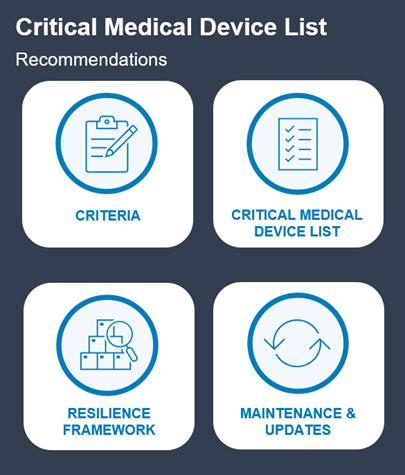Office of Supply Chain Resilience
The mission of the Office of Supply Chain Resilience (OSCR) for medical devices is to strengthen public health supply chains by proactively monitoring, assessing, and communicating risks and vulnerabilities to prevent shortages of medical devices.
OSCR is within CDRH’s Office of Strategic Partnership and Technology Innovation (OST). OSCR provides leadership and strategic direction in medical device supply chain resilience. OSCR consists of two divisions, the Division of Prevention, Innovation and Resilience and the Division of Shortage Assessment and Product Authentication.
What We Do
OSCR was established to enhance the FDA’s capacity to prevent and mitigate supply chain interruptions and promote resiliency in the U.S. medical device supply chain to promote availability of safe and effective medical devices for patients by:
- Developing strategies, analyses, and informational products to help prevent and, when appropriate, mitigate medical device supply chain disruptions and shortages
- Identifying supply chain risks and providing actionable information on those risks to medical device manufacturers, medical device distributors, health care delivery organizations, patients, health care workers, and government partners
- Developing communication channels across the medical device ecosystem to enhance collaborations for development of prevention and risk reduction strategies
- Collaborating with government partners and medical device stakeholders to triage supply chain disruption and/or shortage signals, determine potential impacts, and provide public health information to support an informed response
COVID-19 Response
During the COVID-19 public health emergency, the FDA helped ensure that patients and health care providers had timely and continued access to safe and high-quality medical devices by,
- Implementing shortage authorities granted under the Coronavirus Aid, Relief, and Economic Security Act (CARES) Act.
- Maintaining a public medical device shortage list.
- Performing shortage assessments on signals from consumers, health care personnel, manufacturers, distributors, group purchasing organizations, professional organizations, and other governmental partners, for medical devices such as:
- Personal protective equipment (PPE),
- COVID-19 testing supplies and equipment,
- Ventilators and other related devices.
- Reaching out to device manufacturers, health care delivery organizations, health care providers and distributors to assess supply chain vulnerabilities.
- Collaborating with government partners to inform the Federal government response to supply chain challenges and inform U.S. government decisions to promote domestic production of medical devices.
- Serving as a clearinghouse for testing supply alternatives to help increase the availability of tests for COVID-19.
Divisions
Division of Prevention, Innovation and Resilience
Who We Are
The Division of Prevention, Innovation and Resilience enables proactive interventions and supports innovation that helps ensure medical device availability and enhances the resiliency of the medical device supply chain.
What We Do
- Promote the availability of safe and effective medical devices for patients, healthcare workers, and the US public by employing advanced analytics, technologies, and modeling to proactively monitor and communicate risks to stakeholders in the medical device ecosystem.
- Advance Center-wide integrated approaches for collecting and utilizing supply chain data to enable rapid assessment and proactive interventions.
- Develop, establish, and foster strategic partnerships with key USG, international, and non-governmental stakeholders across the medical device ecosystem to enhance prevention, communication, and coordination and strengthen resiliency.
- Lead and coordinate integrated approaches for advancing evidence-based, data-driven regulatory and policy decisions impacting medical device supply chain resiliency.
- Research, develop, foster and share innovative solutions that promote the availability of safe and effective medical devices.
Division of Shortage Assessment and Product Authentication
Who We Are
The Division of Shortage Assessment and Product Authentication helps to advance supply chain resilience by conducting shortage impact assessments and preventing counterfeit devices from entering the market.
What We Do
- Lead and advance Center efforts to prevent counterfeit and fraudulent items from entering the US medical device supply chain.
- Advance US medical device supply chain resiliency through evidence-based, data-driven public health impact assessments and regulatory mitigations.
- Develop, establish, and foster strategic partnerships with key USG, international, and non-governmental stakeholders across the medical device ecosystem to enhance prevention, communication, and coordination and strengthen resiliency.
Critical Medical Device List (CMDL)
In January 2021, President Biden issued Executive Order 14001 on a Sustainable Public Health Supply Chain, calling for the government and industry to work together to improve supply chain resilience during the COVID-19 pandemic. Following the creation of the National Strategy for a Resilient Public Health Supply Chain, the FDA coordinated an interagency effort to develop recommendations for devices that should be included on a Critical Medical Device List (CMDL).
CMDL provides a list of medical device types where disruptions can lead to serious injury or death to patients or health care providers. The CMDL and associated recommendations were developed by a multi-stakeholder Task Group and are intended to help government, business, and health care leaders prevent disruptions and benefit from supply chain resilience resources.
To develop the CMDL recommendations, a Task Group of Experts (“Task Group”) was established under the Critical Infrastructure Partnership Advisory Council (CIPAC) Healthcare and Public Health (HPH) Sector Joint Supply Chain Resilience Working Group (SCRWG). Task Group members included device manufacturers, distributors, group purchasing organizations, health care systems, and health care providers.
The Task Group’s recommendations included the criteria used to identify critical devices, the list of critical medical device types, a plan for updating the list, and a resilience framework. The intent of the Task Group recommendations is to facilitate resilience through policy, regulatory, procurement, production, and inventory decisions across the medical device ecosystem.
For more details on the background, recommendations, and approach, please review the full CMDL Recommendations Report or the summary CMDL Fact Sheet.
Related pages
- Fact Sheet: Mitigating and Preventing Medical Device Shortages and Prioritizing Public Health
- Medical Device Supply Chain and Shortages
- Medical Device Shortages List
- Contact the FDA About a Medical Device Supply Chain Issue
- Virtual Public Workshop - Building Medical Device Supply Chain Resilience: A Healthcare and Public Health Ecosystem-Wide Collaboration (2022)
- Relevant Guidance Documents:

